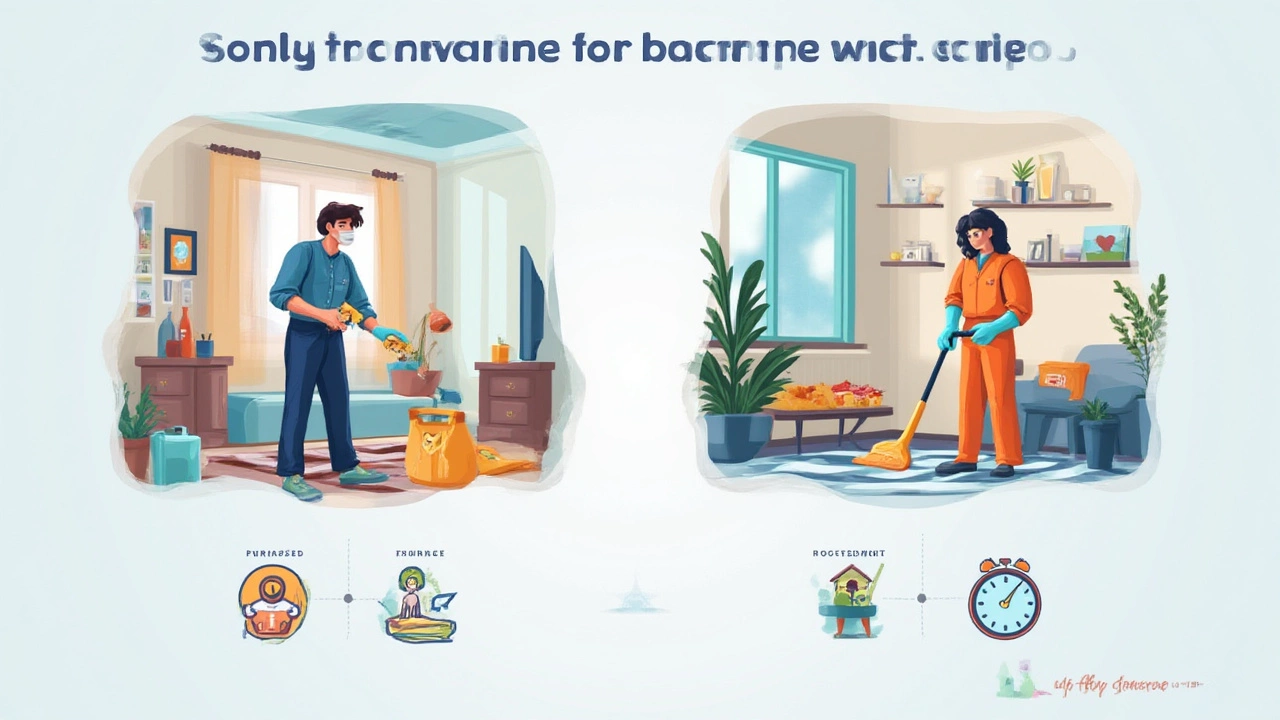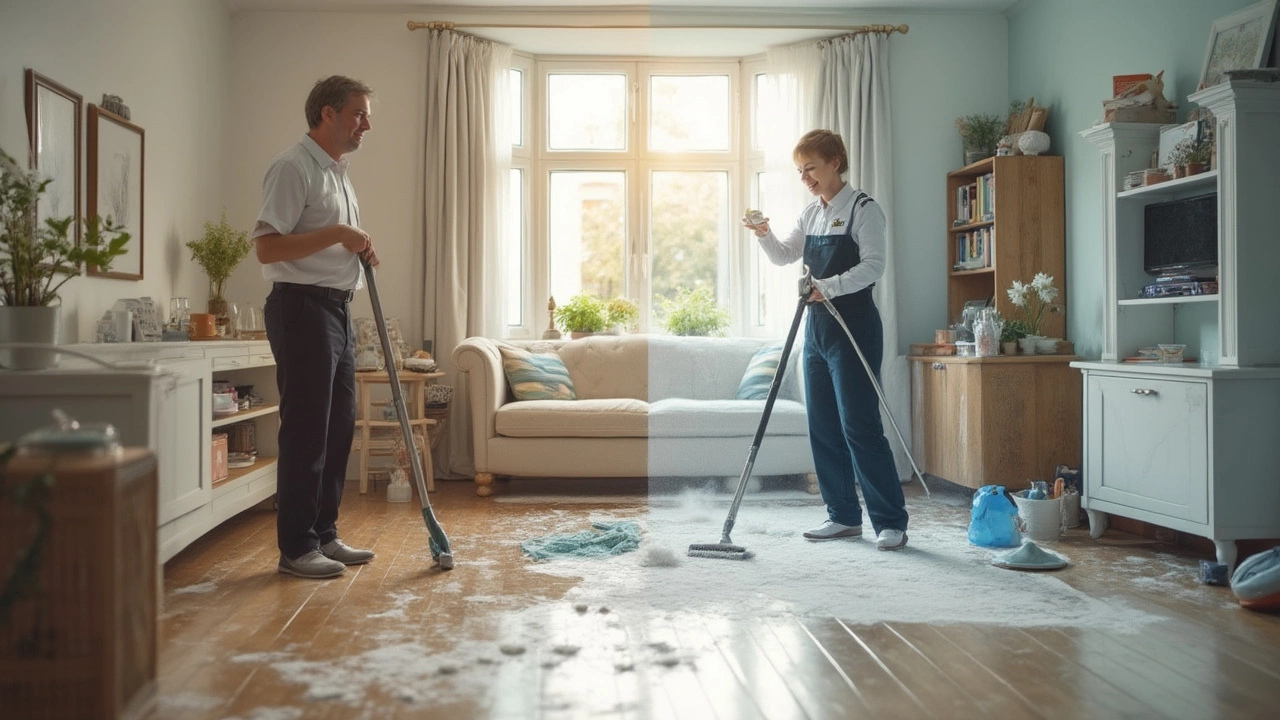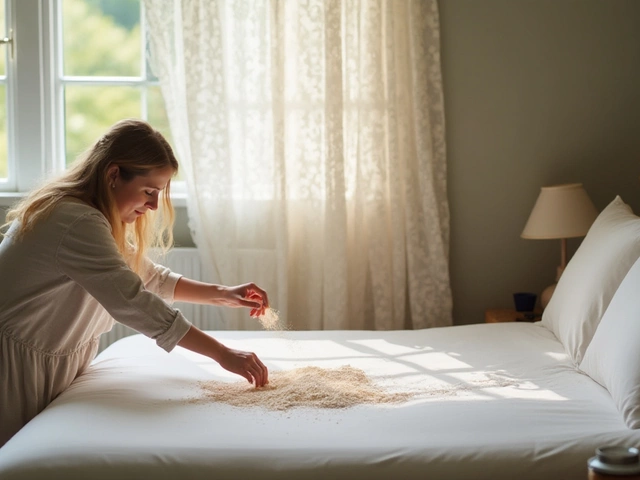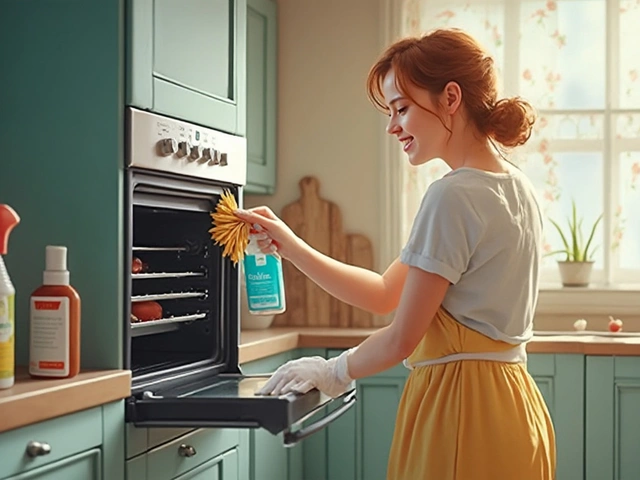Nothing makes you sweat like a surprise visit from your in-laws and the realization that your 'clean' living room isn’t quite so spotless. If you’ve ever wondered why your place never seems as sparkling as that neighbor who just had a cleaning service over, it’s not just you. The world of cleaning splits into two major camps: regular cleaning and professional cleaning. But what really sets them apart—besides a steeper bill for the pros? Whether you’re obsessed with every crumb or live in organized chaos, knowing the real difference changes the way you take care of your space.
The Basics: What Do We Mean By Regular and Professional Cleaning?
Think of regular cleaning as the routine stuff you do to keep chaos at bay. Vacuuming the rug, wiping down counters, a quick mop of the kitchen—basically the kind of cleaning you do each week or even daily, depending how much you (or your pets) shed. Most people, me included, end up chasing cat hair tumbleweeds with the vacuum on autopilot. The main goals? Keep visible surfaces clean, banish obvious mess, and keep your home feeling comfortable.
Professional cleaning goes several levels deeper. It’s a systematic deep dive designed to tackle both the dirt you see and a whole world of grime you never even noticed. Teams arrive armed with commercial-grade supplies, specialized tools, and tons of experience. This isn’t about tidying up—think industrial-strength vacuums that can pull dust mites out of your mattress, high-pressure steamers, microscopic allergen removal, and tackling built-up grime in those "no one will ever look there" corners.
The biggest misconception? Thinking professional cleaning is just your weekly routine but fancier. It’s not. Professionals follow detailed checklists (sometimes hundreds of points long) and use methods regular homeowners never do. There’s usually a focus on sanitation, long-lasting results, and sometimes even air quality. Plus, they work faster, with teams trained to get a home spotless in the time it takes you to figure out where you left your scrub brush.
Tools, Technology, and Techniques: Why the Gear Matters
The stuff you use for cleaning at home usually comes from the same grocery aisle: all-purpose sprays, a mop you curse whenever it leaves streaks, maybe a vacuum that’s been given more duct tape patches than an old sofa.
Professional teams, though, turn up with an entire arsenal. We're talking hospital-grade disinfectants, air-purifying HEPA vacuums, steam cleaners, rotary floor machines, and more. These aren’t just fancy gadgets – they're designed to reach deeper, clean more effectively, and save time.
For instance, a professional-grade vacuum with HEPA filtration is proven to remove 99.97% of particles down to 0.3 microns. That’s crucial when you have allergies, pets like my cat Thistle, or live somewhere dusty. If you try the same with your household vacuum, you’d leave most of the invisible stuff behind.
The cleaning products are another big difference. Regular products rely on basic surfactants and fragrance. Professionals choose pH-balanced or eco-certified chemicals, enzyme cleaners for stains, degreasers strong enough to remove years of kitchen buildup, and products meant for specific surfaces. If you’ve ever wondered how they get glass so streak-free, it’s not just elbow grease – it's specialty blends that don’t leave residues.
And then, there’s technique. Pros don’t just wipe and go. They follow a methodical top-down, left-right pattern, which research (check out ISSA’s best practice guides) proves is quicker and lifts more dirt. Their training often covers everything from chemical safety to cross-contamination prevention, meaning you don’t end up with germs from the toilet on your light switches. At home, most of us don’t even think about that risk.
| Tool/Product | Regular Cleaning | Professional Cleaning |
|---|---|---|
| Vacuum | Basic consumer model | Commercial-grade, HEPA-filtered |
| Mop | Cotton/sponge | Microfiber, steam mops |
| Cleaning Product | Multi-purpose/retail cleaner | Professional/eco-certified/targeted |
| Disinfecting | Bleach/antibacterial wipes | Hospital-grade disinfectants |
| Technique | No formal method | Standardized best practice protocols |

The Time Investment, Frequency, and Scope
You know that sense of defeat when you spend half your Saturday cleaning and it barely looks better? Regular cleaning eats up time. According to the British Cleaning Council, the average person spends four hours a week just on basic cleaning tasks. For families or pet owners, it’s often more—twice that if you’re picky about floors.
But regular cleaning isn’t comprehensive. It keeps things ticking over: makes your bathroom bearable, keeps kitchen spills in check, and ensures your house doesn’t smell like the bin. The focus is short-term maintenance. Most folks wipe down what’s in sight, skip the skirting boards, and only tackle the fridge’s dark corners when something starts to smell. Deep tasks are rare—maybe once a year or when you move out, if ever.
With professional cleaning, you’re paying for a reset. Not something you do weekly (unless you have the budget of a footballer) but more like a quarterly or annual overhaul. The scope is everything, from air vents to under beds, and even those awkward spots behind the loo. End of tenancy cleans, post-renovation, big holiday preps—these are times when a pro team swoops in. Most cleaning contracts specify exactly what’s covered, down to details like polishing fixtures and washing skirting boards.
Want some stats? According to research by the Association of Residential Cleaning Services International, a deep professional clean will, on average, be three to six times more thorough than a regular one, based on the number of surfaces cleaned and the time taken per square meter. Instead of running out of time and energy, you get a home that’s actually close to clinical-level clean—in hours, not days.
Results: What Really Changes After Professional Cleaning?
Here’s the kicker most don’t realize: professional cleaning doesn’t just make things look nice, it changes the way your home functions. Ever noticed how a pro-cleaned place feels fresh for much longer? It’s because hidden build-up holds odours, allergens, and even tiny pests. A thorough clean can dramatically improve indoor air quality, reduce triggers for allergies, and even extend the life of your furniture and appliances by removing grime and abrasive dirt.
I had a client—cat allergies through the roof, constantly fighting sniffles. One deep clean, targeting vent filters, carpets, and pet bedding, and the sniffles dropped by half. Science backs this up: the EPA estimates that indoor air is often two to five times more polluted than outside, with dust, dander, and mold spores lurking in upholstery and corners. Professional methods actually pull those out rather than just shifting dust around.
There’s also the mental boost. Our brains associate clean environments with lower stress and more focus. Ever felt the immediate calm in a freshly cleaned hotel room? Regular at-home cleaning gets you closer to that, but if you want the full reset—nothing matches a pro job.
- Stain removal: Only certain professional processes (think hot water extraction or enzyme treatment) remove stubborn stains fully.
- Odor control: Deep cleaning neutralizes odor sources instead of covering them up with sprays.
- Longevity: Regular professional cleaning, especially for carpets and upholstery, keeps items looking and feeling new—saving cash long-term.
- Hygiene: Bacteria and viruses on touchpoints (like light switches and remotes) are targeted far more precisely by trained teams.
If your space faces high traffic, kids, or pets, the gap only grows. Professional cleaning uncovers and eliminates what you didn’t even realize was there, so the "reset" lasts longer and actually supports better health.

Tips for Getting the Most from Both Types of Cleaning
Even if you love the idea of hiring professionals, most of us live by the rules of regular cleaning. Still, there are ways to smarten up your approach, making regular cleaning more effective and professional deep cleans more worthwhile.
- professional cleaning isn’t a substitute for routine effort: Maintain daily habits like clearing dirty dishes and a nightly counter wipe—less build-up between pro visits means better results.
- Invest in decent equipment: A consumer-grade vacuum with a HEPA filter costs more upfront, but it’ll pick up far more allergens and dust—huge if your household has allergy sufferers.
- Use microfiber cloths: They're proven to pick up more dirt than paper towels or sponges and leave fewer scratches on delicate surfaces.
- Don’t skip overlooked spots: Doorhandles, light switches, remote controls—their germ count rivals toilet seats. A simple disinfectant wipe once a week slashes bacteria risks.
- Call in the pros when it matters: Schedule professional cleaning after a renovation, before allergy season, or if you’re moving in or out. You’ll be amazed how much grime has built up in “clean” spaces.
- Ask pros for checklists: Good companies share their cleaning schedule, so you know what's covered. Compare their process with your regular routine and borrow tips.
- Be mindful of product safety: Especially with kids or pets around (like Thistle in my house), ask about eco-friendly or low-tox options. Many pro teams have these as standard.
There's a rhythm to smart cleaning: stay on top of the everyday mess, then bring out the heavy artillery a few times a year. That combo gives you all the peace of mind and real health benefits—without blowing your weekend or your cash.





